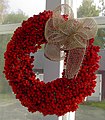Kopparberg
| Kopparberg | ||||
|
||||
| State : | Sweden | |||
| Province (län): | Örebro län | |||
| Historical Province (landskap): | Vastmanland | |||
| Municipality : | Ljusnarsberg | |||
| Coordinates : | 59 ° 53 ′ N , 14 ° 59 ′ E | |||
| SCB code : | 6016 | |||
| Status: | Crime scene | |||
| Residents : | 3065 (December 31, 2015) | |||
| Area : | 5.06 km² | |||
| Population density : | 606 inhabitants / km² | |||
| List of perpetrators in Örebro County | ||||
Kopparberg is a locality ( Tatort ) in the Swedish province of Örebro län and the capital of the municipality of Ljusnarsberg . The place name, originated in 1635 as Nya Kopparbergeett , refers to copper ( Koppar ) and ore deposits ( mountain ). The district of Bångbro used to be an independent place and has grown together with Kopparberg over time.
The place is a former mining settlement and is located about 30 km southwest of Ludvika on the Garrhytteån river. The pit used to mine sulphides was closed in 1975 by the then owner Boliden AB . The mine was on the northern edge of the place and today various objects from the time of use can still be seen. Bångbro developed around an ironworks and a cold rolling mill . Today most of the residents are employed in the public sector. One of the largest companies is the local brewery ( Kopparbergs Bryggeri ) with over 100 employees.
The market days ( Kopparbergsmarken ) around September 29, a day in honor of the Archangel Michael ( Mickelsmäss ), attract most visitors to the town every year. The main streets of the settlement and adjoining paths are transformed into dealer alleys with barkers . Every year around 100,000 people crowd between the stands on these two days.
Kopparberg also gained national fame through a small postage stamp that was canceled here in 1857. The Tre Skilling Banco misprint (in yellow instead of green) is one of the rarest and most expensive postage stamps in the world. At the last auction in Geneva it achieved an amount of 2.5 million Swiss francs .
The village was an independent minority town ( Köping ) until 1962 , before it was united with the rural community of Ljusnarsberg.
photos
Rowanberry wreaths are popular products on the market described






